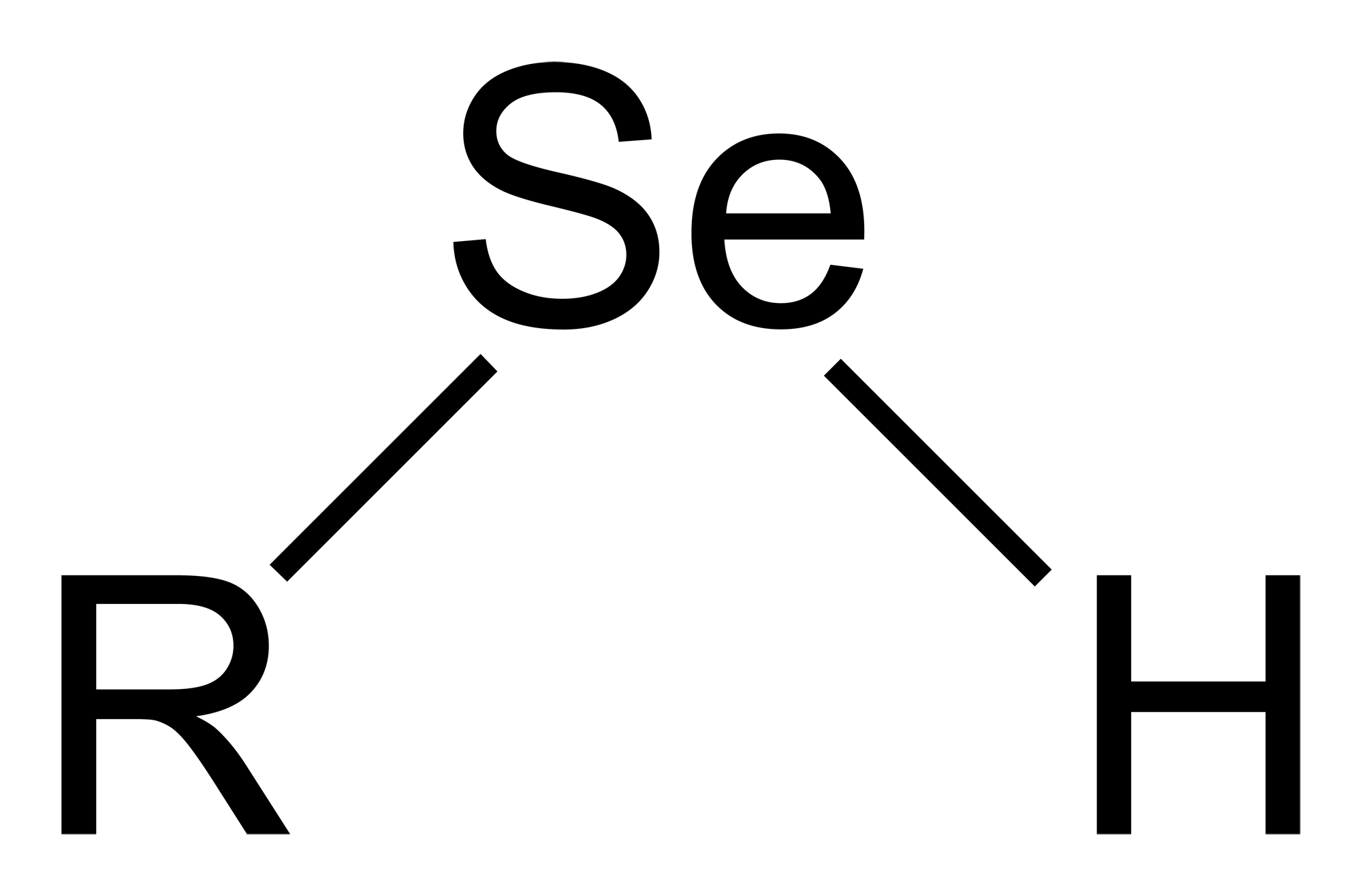|
Organoselenium
Organoselenium chemistry is the science exploring the properties and reactivity of organoselenium compounds, chemical compounds containing carbon-to-selenium chemical bonds. Selenium belongs with oxygen and sulfur to the group 16 elements or chalcogens, and similarities in chemistry are to be expected. Organoselenium compounds are found at trace levels in ambient waters, soils and sediments. Selenium can exist with oxidation state −2, +2, +4, +6. Se(II) is the dominant form in organoselenium chemistry. Down the group 16 column, the bond strength becomes increasingly weaker (234 kJ/ mol for the bond and 272 kJ/mol for the bond) and the bond lengths longer ( 198 pm, 181 pm and 141 pm). Selenium compounds are more nucleophilic than the corresponding sulfur compounds and also more acidic. The p''K''a values of are 16 for oxygen, 7 for sulfur and 3.8 for selenium. In contrast to sulfoxides, the corresponding selenoxides are unstable in the presence of β-protons and this propert ... [...More Info...] [...Related Items...] OR: [Wikipedia] [Google] [Baidu] |
Selenol
Selenols are organic compounds that contain the functional group with the connectivity . Selenols are sometimes also called selenomercaptans and selenothiols. Selenols are one of the principal classes of organoselenium compounds. A well-known selenol is the amino acid selenocysteine. Structure and properties Selenols are structurally similar to thiols, but the bond is about 8% longer at 196 pm. The angle approaches 90°. The bonding involves almost pure p-orbitals on Se, hence the near 90 angles. The bond energy is weaker than the bond, consequently selenols are easily oxidized and serve as H-atom donors. The Se-H bond is weaker than the bond as reflected in their respective bond dissociation energy (BDE). For , the BDE is 326 kJ/mol, while for , the BDE is 368 kJ/mol. Selenols are about 1000 times stronger acids than thiols: the p''K''a of is 5.2 vs 8.3 for . Deprotonation affords the selenolate anion, , most examples of which are highly nucleophilic and rapidly o ... [...More Info...] [...Related Items...] OR: [Wikipedia] [Google] [Baidu] |
Selenium
Selenium is a chemical element; it has symbol (chemistry), symbol Se and atomic number 34. It has various physical appearances, including a brick-red powder, a vitreous black solid, and a grey metallic-looking form. It seldom occurs in this elemental state or as pure ore compounds in Earth's crust. Selenium ( ) was discovered in 1817 by , who noted the similarity of the new element to the previously discovered tellurium (named for the Earth). Selenium is found in :Sulfide minerals, metal sulfide ores, where it substitutes for sulfur. Commercially, selenium is produced as a byproduct in the refining of these ores. Minerals that are pure selenide or selenate compounds are rare. The chief commercial uses for selenium today are glassmaking and pigments. Selenium is a semiconductor and is used in photocells. Applications in electronics, once important, have been mostly replaced with silicon semiconductor devices. Selenium is still used in a few types of Direct current, DC power surge ... [...More Info...] [...Related Items...] OR: [Wikipedia] [Google] [Baidu] |
Benzeneselenol
Benzeneselenol, also known as selenophenol, is the organoselenium compound with the chemical formula , often abbreviated PhSeH. It is the selenium analog of phenol. This colourless, malodorous compound is a reagent in organic synthesis. Synthesis Benzeneselenol is prepared by the reaction of phenylmagnesium bromide and selenium: :PhMgBr + Se → PhSeMgBr :PhSeMgBr + HCl → PhSeH + MgBrCl Since benzeneselenol does not have a long shelf life, it is often generated in situ. A common method is by reduction of diphenyldiselenide. A further reason for this conversion is that often, it is the anion that is sought. Reactions More so than thiophenol, benzeneselenol is easily oxidized by air. The facility of this reaction reflects the weakness of the Se-H bond, bond dissociation energy of which is estimated to be between 67 and 74 kcal/mol. In contrast, the S-H BDE for thiophenol is near 80 kcal/mol. The product is diphenyl diselenide as shown in this idealized equation: : The presen ... [...More Info...] [...Related Items...] OR: [Wikipedia] [Google] [Baidu] |
Diethyl Selenide
Diethyl selenide is an organoselenium compound with the formula . First reported in 1836, it was the first organoselenium compound to be discovered. It is the selenium analogue of diethyl ether. It has a strong and unpleasant smell. Occurrence Diethyl selenide has been detected in biofuel produced from plantain peel. It is also a minor air pollutant in some areas. Preparation It may be prepared by a substitution reaction similar to the Williamson ether synthesis: reaction of a metal selenide, such as sodium selenide, with two equivalents of ethyl iodide or similar reagent to supply the ethyl group In organic chemistry, an ethyl group (abbr. Et) is an alkyl substituent with the formula , derived from ethane (). ''Ethyl'' is used in the International Union of Pure and Applied Chemistry The International Union of Pure and Applied ...s: References {{reflist Selenoethers Foul-smelling chemicals ... [...More Info...] [...Related Items...] OR: [Wikipedia] [Google] [Baidu] |
Group 16 Element
The chalcogens (ore forming) ( ) are the chemical elements in group (periodic table), group 16 of the periodic table. This group is also known as the oxygen family. Group 16 consists of the elements oxygen (O), sulfur (S), selenium (Se), tellurium (Te), and the Radioactive decay, radioactive elements polonium (Po) and livermorium (Lv). Often, oxygen is treated separately from the other chalcogens, sometimes even excluded from the scope of the term "chalcogen" altogether, due to its very different chemical behavior from sulfur, selenium, tellurium, and polonium. The word "chalcogen" is derived from a combination of the Greek word () principally meaning copper (the term was also used for bronze, brass, any metal in the poetic sense, ore and coin), and the Latinized Greek word , meaning ''born'' or ''produced''. Sulfur has been known since antiquity, and oxygen was recognized as an element in the 18th century. Selenium, tellurium and polonium were discovered in the 19th century, a ... [...More Info...] [...Related Items...] OR: [Wikipedia] [Google] [Baidu] |
Sodium Selenide
Sodium selenide is an inorganic compound of sodium and selenium with the chemical formula Na2Se. Preparation This colourless solid is prepared by the reaction of selenium with a solution of sodium in liquid ammonia at −40 °C.Brauer, G. ed. (1963) ''Handbook of Preparative Inorganic Chemistry'', 2nd Ed., Academic Press, NY., Vol. 1. p. 421. Alternatively, sodium selenide can be prepared by the reaction of gaseous hydrogen selenide with metallic sodium at 100 °C. Reactions Like other alkali metal chalcogenides, this material is highly sensitive to water, easily undergoing hydrolysis to give mixtures of sodium biselenide (NaSeH) and hydroxide. This hydrolysis occurs because of the extreme basicity of the Se2− ion. :Na2Se + H2O → NaHSe + NaOH Similarly, sodium selenide is readily oxidized to polyselenides, a conversion signaled by off-white samples. Sodium selenide reacts with acids to produce toxic hydrogen selenide gas. :Na2Se + 2 HCl → H2Se + 2 NaCl The compound ... [...More Info...] [...Related Items...] OR: [Wikipedia] [Google] [Baidu] |
Dimethylselenide
Dimethyl selenide is the organoselenium compound with the formula (CH3)2Se. This colorless, malodorous liquid is the simplest selenoether. It occurs in trace amounts in anaerobic environments and in the atmosphere due to biomethylation of selenium. Dimethyl selenide is prepared by treating Se2− sources with electrophilic methylating agents such as methyl iodide: :Na2Se + 2 CH3I → (CH3)2Se + 2 NaI The carbon–selenium bond length is 1.943 Å and the C–Se–C bond angle is 96.2°, as determined by rotational microwave spectroscopy. Similar dimensions of 1.98 Å and 98° are found by gas electron diffraction Gas electron diffraction (GED) is one of the applications of electron diffraction techniques. The target of this method is the determination of the structure of gaseous molecules, i.e., the geometrical arrangement of the atoms from which a molec .... References {{Selenium compounds Selenium(−II) compounds Selenoethers Foul-smelling chemicals Methyl compoun ... [...More Info...] [...Related Items...] OR: [Wikipedia] [Google] [Baidu] |
Disulfide
In chemistry, a disulfide (or disulphide in British English) is a compound containing a functional group or the anion. The linkage is also called an SS-bond or sometimes a disulfide bridge and usually derived from two thiol groups. In inorganic chemistry, the anion appears in a few rare minerals, but the functional group has tremendous importance in biochemistry. Disulfide bridges formed between thiol groups in two cysteine residues are an important component of the tertiary and quaternary structure of proteins. Compounds of the form are usually called ''persulfides'' instead. Organic disulfides Structure Disulfides have a C–S–S–C dihedral angle approaching 90°. The S–S bond length is 2.03 Å in diphenyl disulfide, similar to that in elemental sulfur. Disulfides are usually symmetric but they can also be unsymmetric. Symmetrical disulfides are compounds of the formula . Most disulfides encountered in organosulfur chemistry are symmetrical disulfides. Unsymme ... [...More Info...] [...Related Items...] OR: [Wikipedia] [Google] [Baidu] |
Organic Syntheses
''Organic Syntheses'' is a peer-reviewed scientific journal that was established in 1921. It publishes detailed and checked procedures for the synthesis of organic compounds. A unique feature of the review process is that all of the data and experiments reported in an article must be successfully repeated in the laboratory of a member of the editorial board as a check for reproducibility prior to publication. The journal is published by Organic Syntheses, Inc., a non-profit corporation. An annual print version is published by John Wiley & Sons on behalf of Organic Syntheses, Inc. History Prior to World War I, work on synthetic organic chemistry in the United States had been quite limited, and most of the reagents used in laboratories had to be imported from Europe. When export stoppages and trade embargoes cut off this source, Clarence Derick, a professor of chemistry at University of Illinois at Urbana-Champaign, began an effort to synthesize these needed chemicals in industri ... [...More Info...] [...Related Items...] OR: [Wikipedia] [Google] [Baidu] |
Diphenyldiselenide
Diphenyl diselenide is the chemical compound with the formula (C6H5)2Se2, abbreviated Ph2Se2. This yellow-coloured solid is the oxidized derivative of benzeneselenol. It is used as a source of the PhSe unit in organic synthesis. Preparation and properties Ph2Se2 is prepared by the oxidation of benzeneselenoate, the conjugate base of benzeneselenol which is generated via the Grignard reagent: : PhMgBr + Se → PhSeMgBr :2 PhSeMgBr + Br2 → Ph2Se2 + 2 MgBr2 The molecule has idealized C2-symmetry, like hydrogen peroxide and related molecules. The Se-Se bond length of 2.29 Å the C-Se-Se-C dihedral angle is 82° and the C-Se-Se angles are near 110°. Medical applications Diphenyl diselenide alleviates methylmercury poisoning in grass carp. Reactions A reaction characteristic of Ph2Se2 is its reduction: :Ph2Se2 + 2 Na → 2 PhSeNa PhSeNa is a useful nucleophile used to introduce the phenylselenyl group by nucleophilic substitution of alkyl halides, alkyl sulfonates ( mesyl ... [...More Info...] [...Related Items...] OR: [Wikipedia] [Google] [Baidu] |
Ether
In organic chemistry, ethers are a class of compounds that contain an ether group, a single oxygen atom bonded to two separate carbon atoms, each part of an organyl group (e.g., alkyl or aryl). They have the general formula , where R and R′ represent the organyl groups. Ethers can again be classified into two varieties: if the organyl groups are the same on both sides of the oxygen atom, then it is a simple or symmetrical ether, whereas if they are different, the ethers are called mixed or unsymmetrical ethers. A typical example of the first group is the solvent and anaesthetic diethyl ether, commonly referred to simply as "ether" (). Ethers are common in organic chemistry and even more prevalent in biochemistry, as they are common linkages in carbohydrates and lignin. Structure and bonding Ethers feature bent linkages. In dimethyl ether, the bond angle is 111° and C–O distances are 141 pm. The barrier to rotation about the C–O bonds is low. The bonding of ox ... [...More Info...] [...Related Items...] OR: [Wikipedia] [Google] [Baidu] |





